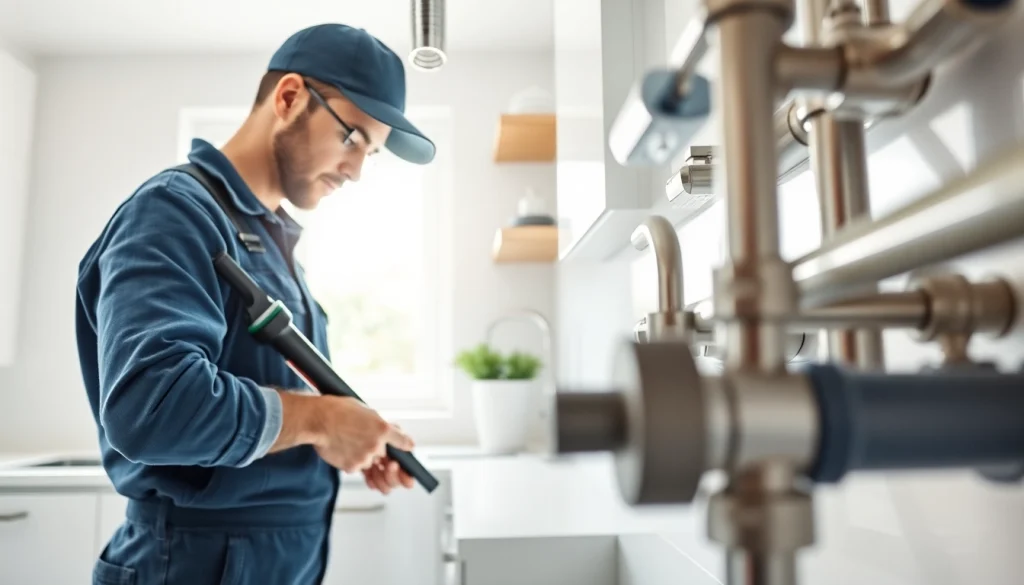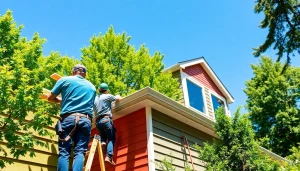Expert Plumbing Techniques for Homeowners: A Comprehensive Guide

Understanding the Basics of Plumbing
Plumbing is a crucial aspect of modern living, integral to our homes and the sanitation systems that keep our environments healthy. It deals with the conveyance of fluids for various applications, using a network of pipes, valves, fittings, and fixtures to ensure water supply and waste management. To gain a comprehensive understanding of plumbing, we first need to delve into what plumbing really is, its key components, and the common problems homeowners face in this domain. For more insight on plumbing, let’s explore each element step by step.
What Is Plumbing?
At its core, plumbing refers to the systems of pipes and fixtures involved in the transport of water, sewage, and other fluids. It encompasses two main subsystems: the supply system, which provides fresh water to a variety of fixtures, and the drainage system, which carries waste away from fixtures. Each subsystem has its unique components and functions, and understanding these can help you diagnose and resolve plumbing issues more effectively.
Key Components of Plumbing Systems
Plumbing systems consist of numerous essential components that work in harmony. Understanding these key parts aids in recognizing potential problems or better managing your plumbing maintenance:
- Pipes: The main conduits that carry water and waste. Common materials include PVC, copper, and PEX.
- Fittings: Connectors that join two or more pieces of pipe. These include elbows, tees, and couplings.
- Fixtures: The end points of plumbing where water is delivered or waste is removed, such as sinks, toilets, and showers.
- Valves: Devices that control the flow of water within the system. Common types include shut-off valves and pressure-reducing valves.
- Traps: Curved pipes that prevent sewer gases from entering the home by holding a small amount of water.
- Drains: Channels that guide waste and wastewater away from fixtures toward the sewer or septic system.
Common Plumbing Issues and Solutions
Every homeowner should be aware of common plumbing problems and their respective solutions.
- Leaky Faucets: Often caused by worn washers or seals. Replacing these components usually solves the problem.
- Clogged Drains: Common in kitchens and bathrooms. Using a plunger or a drain snake can help dislodge blockages.
- Running Toilets: Typically a sign of a faulty flapper valve. Replacing the valve generally resolves the issue.
- Low Water Pressure: May indicate clogs or leaks in your pipes or issues with fixtures. Troubleshooting often requires a thorough inspection of the system.
Essential Tools Every Plumber Should Have
Having the right tools is fundamental for any plumbing work, whether it’s a DIY repair or professional installation. Below is a detailed look at essential plumbing tools that can help in accomplishing various tasks effectively.
Hand Tools for Plumbers
Every plumber’s toolkit should include hand tools designed for both efficiency and safety:
- Pipe Wrench: Essential for gripping, turning, and securing pipes and various fittings.
- Adjustable Wrench: Perfect for tightening and loosening nuts and bolts of all sizes.
- Crescent Wrench: A versatile tool that allows for adjustable jaw sizes, making it suitable for various applications.
- Plumber’s Tape: Used to create a watertight seal on threaded joints to prevent leaks.
- Pipe Cutter: An essential tool for cutting pipes smoothly and precisely.
Power Tools and Their Uses
While hand tools are great for smaller tasks, power tools can significantly enhance speed and efficiency in plumbing projects:
- Drill: Ideal for making holes in various materials, especially while installing fixtures.
- Reciprocating Saw: Useful for cutting pipes, wood, and other construction materials quickly.
- Angle Grinder: Often employed for cutting and grinding metal pipes and fittings.
Maintenance and Care for Plumbing Tools
Just as with plumbing systems themselves, maintaining tools is crucial to ensure their longevity and effectiveness:
- Regularly clean tools after each use to avoid rust and damage.
- Store tools in a dry environment to prevent electrical and metal components from corroding.
- Inspect tools often for wear and tear, replacing any damaged components promptly.
DIY Plumbing Tips for Homeowners
Homeowners can often tackle simple plumbing issues themselves, saving time and money. Here are some practical tips to guide you through common tasks.
Simple Repairs You Can Tackle
Many minor issues require basic skills and tools:
- Unclogging Drains: A mix of baking soda and vinegar can break down clogs. Alternatively, use a plunger for minor blockages.
- Replacing a Showerhead: Simply unscrewing the old one and replacing it with a new model can enhance water efficiency and performance.
- Fixing Leaky Toilets: Replacing flappers and washer seals is a straightforward process that requires minimal tools.
When to Call a Professional
While DIY fixes can be beneficial, certain problems require professional intervention:
- Extensive plumbing problems involving major leaks or pipe damage.
- Yard drainage issues that require specialized knowledge of septic systems.
- Any work requiring a permit or that significantly alters your plumbing architecture.
Preventive Measures to Avoid Plumbing Issues
Avoiding problems before they arise is key in plumbing:
- Regular inspections of your plumbing system can help catch issues early.
- Use drain guards to catch hair and debris, preventing clogs.
- Keep grease and harsh chemicals away from your drains to avoid damaging your plumbing.
Innovative Plumbing Technologies
The plumbing industry continues to evolve, providing homeowners with innovative options that enhance efficiency and sustainability.
Smart Plumbing Devices
Smart technology integrates seamlessly into modern plumbing systems, offering numerous benefits:
- Smart Leak Detectors: Alert you to leaks, minimizing water damage.
- Wi-Fi-Enabled Water Valves: Allow remote monitoring and control over water usage, great for managing emergencies.
- Smart Showers: Provide programmable temperature control and water-saving settings.
Benefits of Tankless Water Heaters
Many households are now opting for tankless water heaters, which provide on-demand hot water. The benefits include:
- Energy Efficiency: Eliminates standby heat loss associated with conventional heaters.
- Space Saving: Compact design frees up floor space.
- Longevity: Typically last longer than traditional units, leading to less frequent replacements.
Eco-Friendly Plumbing Solutions
Adopting eco-friendly solutions contributes to sustainability:
- Low-flow faucets and showerheads significantly reduce water consumption.
- Rainwater harvesting systems help in using natural water resources more efficiently.
- Biodegradable drain cleaners offer a safer alternative to harsh chemicals, protecting your plumbing and the environment.
Choosing the Right Plumbing Service
When you require a professional service, selecting the right plumbing company is essential for quality service.
What to Look for in a Plumbing Company
Assess potential plumbing companies based on specific criteria to ensure you receive reliable service:
- Licensing and Certification: Ensure that the plumbing service is licensed and adheres to local regulations.
- Experience: Look for a company with a solid track record and experience in dealing with issues similar to yours.
- Insurance: Any reputable plumbing company should carry liability insurance, safeguarding against accidents or damage.
Understanding Plumbing Costs and Estimates
Knowing how to interpret costs and estimates can aid in making informed decisions:
- Request detailed estimates that break down labor and material costs to understand the pricing fully.
- Compare quotes from multiple suppliers, weighing both costs and company reputations.
- Inquire about warranties offered on parts and workmanship to ensure you are protected long-term.
Questions to Ask Before Hiring a Plumber
Engaging with potential plumbing services can clarify expectations and capabilities. Consider asking:
- What is your response time in case of emergencies?
- Can you provide references from past customers?
- What warranties do you offer for your work and materials?





